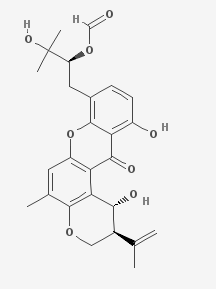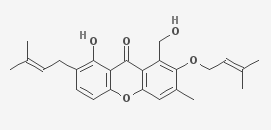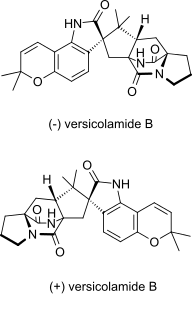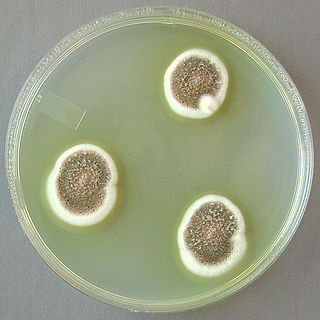
Aspergillus is a genus consisting of several hundred mold species found in various climates worldwide.

Aspergillus nidulans is one of many species of filamentous fungi in the phylum Ascomycota. It has been an important research organism for studying eukaryotic cell biology for over 50 years, being used to study a wide range of subjects including recombination, DNA repair, mutation, cell cycle control, tubulin, chromatin, nucleokinesis, pathogenesis, metabolism, and experimental evolution. It is one of the few species in its genus able to form sexual spores through meiosis, allowing crossing of strains in the laboratory. A. nidulans is a homothallic fungus, meaning it is able to self-fertilize and form fruiting bodies in the absence of a mating partner. It has septate hyphae with a woolly colony texture and white mycelia. The green colour of wild-type colonies is due to pigmentation of the spores, while mutations in the pigmentation pathway can produce other spore colours.
Aspergillus ochraceus is a mold species in the genus Aspergillus known to produce the toxin ochratoxin A, one of the most abundant food-contaminating mycotoxins, and citrinin. It also produces the dihydroisocoumarin mellein. It is a filamentous fungus in nature and has characteristic biseriate conidiophores. Traditionally a soil fungus, has now began to adapt to varied ecological niches, like agricultural commodities, farmed animal and marine species. In humans and animals the consumption of this fungus produces chronic neurotoxic, immunosuppressive, genotoxic, carcinogenic and teratogenic effects. Its airborne spores are one of the potential causes of asthma in children and lung diseases in humans. The pig and chicken populations in the farms are the most affected by this fungus and its mycotoxins. Certain fungicides like mancozeb, copper oxychloride, and sulfur have inhibitory effects on the growth of this fungus and its mycotoxin producing capacities.
Emericella is a genus of fungi.

Varixanthone is an antimicrobial made by the marine fungus Emericella variecolor.

Isoemericellin is a bio-active isolate of the marine fungus Emericella variecolor.

Arugosin C is an anthraquinone derivative isolated from a species of Aspergillus found in the Red Sea.

Siderin is a bio-active coumarin derivative produced by Aspergillus versicolor, an endophytic fungus found in the green alga Halimeda opuntia in the Red Sea.

(-)-Versicolamide B and (+)-Versicolamide B are spiroindole alkaloids isolated from the fungus Aspergillus that belong to a class of naturally occurring 2,5-diketopiperazines. The versicolamides are structurally complex spiro-cyclized versions of prenylated cyclo(L-Trp-L-Pro) derivatives which possess a unique spiro-fusion to a pyrrolidine at the 3-position of the oxindole core together with the bicyclo[2.2.2]diazaoctane ring system. While (-)-versicolamide B was isolated from the marine fungus Aspergillus sp. the enantiomer (+)-versicolamide B was isolated from the terrestrial fungi Aspergillus versicolor NRRL. The total asymmetric syntheses of both enantiomers have been achieved and the implications of their biosynthesis have been investigated.

Aspergillus versicolor is a slow-growing filamentous fungus commonly found in damp indoor environments and on food products. It has a characteristic musty odor associated with moldy homes and is a major producer of the hepatotoxic and carcinogenic mycotoxin sterigmatocystin. Like other Aspergillus species, A. versicolor is an eye, nose, and throat irritant.

Aspergillus ustus is a microfungus and member of the division Ascomycota. It is commonly found in indoor environments and soil. Isolated cases of human infection resulting from A. ustus have been described; however the majority of these are nail infections.
Fungal isolates have been researched for decades. Because fungi often exist in thin mycelial monolayers, with no protective shell, immune system, and limited mobility, they have developed the ability to synthesize a variety of unusual compounds for survival. Researchers have discovered fungal isolates with anticancer, antimicrobial, immunomodulatory, and other bio-active properties. The first statins, β-Lactam antibiotics, as well as a few important antifungals, were discovered in fungi.
Aspergillus unguis is a species of fungus in the genus Aspergillus, and the asexual state (anamorph) of Emericella unguis. Aspergillus unguis is a filamentous soil-borne fungus found on decomposing plant matter and other moist substrates including with building materials and household dust. Aspergillus unguis occurs mainly in tropical and subtropical soils but has also been isolated from various marine and aquatic habitats. The species was first isolated in 1935 by Weill and L. Gaudin. Historically, A. unguis was assigned to the A. nidulans group, a common group of soil-borne fungi due to the resemblance of its ascospores and cleistothecia to those of Emericella nidulans. Aspergillus unguis is distinctive, however, in possessing spicular hyphae. A number of synonyms have been collapsed into this species, including Sterigmatocystis unguis, Aspergillus laokiashanensis and Aspergillus mellinus.
Aspergillus desertorum is a species of fungus in the genus Aspergillus which has been isolated from desert soil. It is from the Nidulantes section. Aspergillus desertorum produces desertorin A, desertorin B, desertorin C, paxiline and emindol DA.
Aspergillus navahoensis is a species of fungus in the genus Aspergillus. It is from the Nidulantes section. The species was first described in 1982. It was isolated from sand in Arizona, United States. It has been reported to produce averufin, norsolorinic acid, 6,7,8-trihydroxy-3-methylisocoumarin, desferritriacetylfusigen, echinocandin B, and sterigmatocystin.
Aspergillus dimorphicus is a species of fungus in the genus Aspergillus. It is from the Cremei section. The species was first described in 1969. It has been reported to produce wentilactones.
Aspergillus corrugatus is a species of fungus in the genus Aspergillus. It is from the Nidulantes section. The species was first described in 1976. It has been isolated from soil in Thailand. It has been reported to produce asperthecin, emecorrugatin A, emecorrugatin B, sterigmatocystin, and norsolorinic acid.
Aspergillus conjunctus is a species of fungus in the genus Aspergillus. It is from the Sparsi section. The species was first described in 1965. It has been isolated from forest soil in Costa Rica. It has been reported to produce auroglaucin.
Aspergillus sparsus is a species of fungus in the genus Aspergillus. It is from the Sparsi section. The species was first described in 1944. It has been isolated from soil in Costa Rica and the United States.
Aspergillus carneus is a fast-growing, filamentous fungus found on detritus and in fertile soil worldwide. It is characterized by its yellow, thick-walled hyphae and biseriate sterigmata. The fungus produces citrinin and 5 unique depsipeptides, Aspergillicins A-E.









